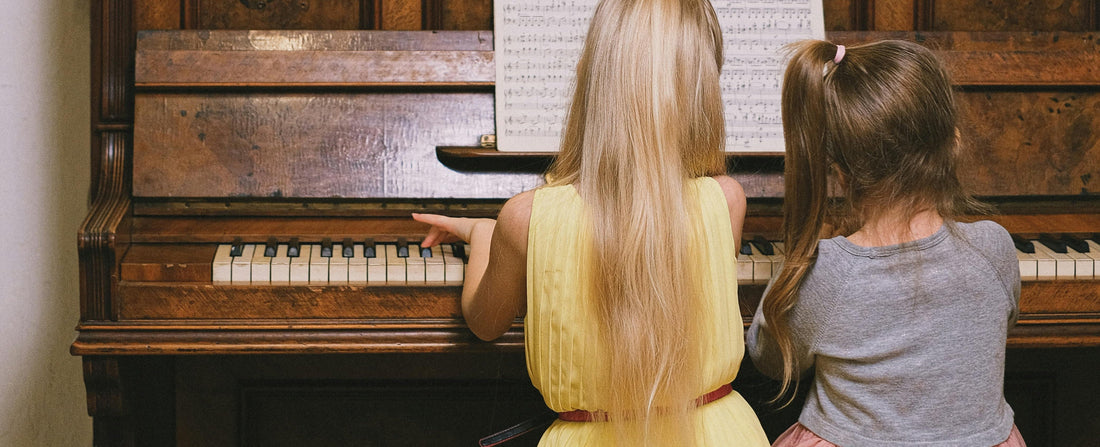
How to Support Your Child’s Piano Practice
Share
When it comes to home practice, many parents feel unsure about the best way to support their child, especially if they don’t play an instrument themselves.
This guide is designed to give you clear, practical steps to support your child’s piano learning journey at home.
Understand Your Role in Practice
First, it’s helpful to understand what your role looks like in this process. As a parent, you are not expected to become your child’s piano teacher at home. You don’t need to correct their hand position or read their sheet music.
Your role is to create the environment for practice to happen and to provide encouragement along the way. Think of yourself as the coach on the sidelines cheering them on, celebrating progress, and helping them stay consistent.
In our experience, the most successful young students have parents who stay involved with gentle structure and positive support.
Set Up a Practice Routine
Consistency matters more than perfection. Rather than long, occasional practice sessions, short and frequent practice works best for beginners.
For young children, we recommend:
- 5 to 10 minutes a day for new beginners
- Practicing most days of the week, aiming for consistency
- Choosing a regular time of day that fits your family’s routine
Some families find it helpful to pair practice with another daily habit (habit stacking), like practicing after breakfast or before dinner. Others like to use visual charts or calendars to track practice and celebrate consistency.
If your child is feeling tired or unmotivated, it’s okay to scale back for a day or two. Consistency over time is more important than perfection every day.
Create an Inviting Practice Space
The practice environment at home plays a big role in your child’s motivation and focus.
Aim for a space that is:
- Quiet and free from distractions
- Well-lit and comfortable
- Equipped with a sturdy bench and proper piano height
Adjust Bench Height
It’s also important to check that your child is sitting at the right height. Ideally, their forearms should be parallel to the floor when playing. Many benches sit too low for young beginners, so using an adjustable bench or a firm cushion can make a big difference in their comfort and technique. In beginner lessons, we recommend the student record themselves playing. In class, we’ll go over the setup and provide recommendations on whether the bench height should be adjusted, or footstools should be added.
If your child’s feet don’t yet reach the floor, it helps to add a small footstool or riser beneath their feet. This extra support keeps them balanced and comfortable while playing, and it encourages good posture at the piano from the very beginning.
Provide Some Privacy
When possible, choose a space with some privacy. Practicing in a busy area of the house, like the kitchen or living room, can make it harder for your child to concentrate. With people walking by or background noise from conversations and screens, it can feel difficult for children to explore their creativity and stay focused. A quieter corner of the home helps your child feel safe to make mistakes, try new things, and enjoy the process of learning.
Beyond physical setup, consider the emotional tone of the space. Children practice best in an environment where mistakes are welcomed as part of the process. Try to keep the practice area low-pressure and encouraging. This helps children feel safe to explore, take risks, and build confidence as they learn.
Provide a Good Quality Instrument
If you’re using a digital piano or keyboard, make sure it is set up properly with a music stand and power supply. Even at the beginner level, having an instrument with weighted keys and a full 88-key range supports good technique and helps your child develop finger strength and control. While it doesn’t need to be a concert grand piano, a quality instrument gives your child the best start.
You can also add small touches to make the space more engaging. A simple practice tracker or colourful reminder of posture tips nearby encourages independence. Having a favourite pencil and notebook at hand can make practice feel organized and special.
Your child doesn’t need a grand piano to enjoy their lessons. What matters most is that their practice space feels like a welcoming, positive place where they can grow as a young musician.
Encourage Small Wins
Progress on the piano is built from many small steps. Celebrate these milestones with your child to keep motivation high and build their confidence.
Look for opportunities to say:
- "I love how focused you were today."
- "That piece sounded even better than last time."
- "I can hear your improvement!"
Even when your child makes mistakes, remind them that it’s a natural part of learning. Mistakes are not failures. They are signs of progress and exploration. Progress is practice plus patience. Your encouragement makes a big difference in helping your child believe in themselves.
Know When to Sit Nearby (and When to Step Back)
One of the most common questions parents have is how involved they should be during practice time at home. Should you sit beside your child the whole time? Step away completely? Check in occasionally?
The answer, like many things in music education, depends on your child, and it can change over time.
In the early stages, many children benefit from having a parent close by. Your quiet presence can offer a sense of security, help them stay focused, and encourage healthy practice habits.
You can support them by:
- Sitting nearby with a book or light task
- Offering gentle reminders when they drift off track
- Noticing when they complete a section and giving specific praise ("I loved how you repeated that section so carefully!")
However, it’s important to recognize that every child responds differently. Some children feel more at ease with a parent present, while others, especially shy or sensitive learners, might feel a little more pressure when someone is watching closely, even when that person is well-meaning.
Rather than assuming one approach works for all, we encourage parents to observe their child’s reactions and adjust support as needed. This is called scaffolding. You provide the right amount of support based on your child’s needs and gradually reduce it as they grow more independent.
If you notice your child:
- Becomes tense or overly cautious in your presence
- Seems hesitant to try something new in front of you
- Fixates on making everything perfect rather than exploring
It might be helpful to give them a bit of space. Reassure them that practice time is their opportunity to explore, take small risks, and grow at their own pace.
For parents who are naturally hands-on, this can feel like a balancing act. Remember, your role evolves as your child builds skills and confidence. You are helping them develop both musical abilities and internal motivation. Even if you choose to step away for parts of practice, your encouragement and interest afterward continue to make a big impact.
Conversely, if your child seems unfocused or unsure when practicing alone, your gentle presence nearby can be grounding and reassuring. Many children appreciate knowing that their efforts are noticed, even if you are simply sitting close and offering a smile of encouragement.
As your child grows, you will likely find your role shifting. What begins as close support can gradually evolve into quiet observation, and eventually, into celebrating their independence. This natural progression is a wonderful milestone to celebrate together.
If you would like more guidance on how to read your child’s cues, we have prepared a simple Parent Involvement Quiz to help you decide how to best support your child’s practice style.
Communicate with Your Teacher
Your child’s teacher is your partner in this journey. If you’re ever unsure about how to support practice at home, don’t hesitate to reach out. Open communication is one of the most valuable tools in helping your child succeed.
Every child’s learning journey is different, and small adjustments at home can make a big impact. We welcome questions like:
- "What should we focus on in practice this week?"
- "How can I help if my child feels frustrated or stuck?"
- "Do you have suggestions for keeping practice fresh and fun?"
- "What should I listen for when my child plays their piece?"
We actively encourage this kind of communication. In fact, you’ll find space in your child’s homework book each week dedicated to practice notes and parent-teacher communication. This is your place to check for practice goals and share any insights from home practice that can help us support your child better.
We want you to feel confident supporting your child, and your feedback helps us adjust lessons to your child’s unique needs. Whether it’s celebrating a success, troubleshooting a challenge, or simply keeping practice enjoyable, we’re here to collaborate with you.
When families and teachers work together, students feel supported from all sides, and that feeling of support builds both confidence and motivation.
Make Practice Fun and Creative
Practice doesn’t have to feel like a chore. In fact, the more playful you can make it, the more your child will want to come back to the piano.
Here are a few creative ideas:
- Let your child give "mini concerts" for family members
- Record short videos of their progress to share with grandparents
- Use fun practice games like "play it three times in a row"
- Explore simple improvisation or creative challenges between assignments
These small touches help keep practice fresh and enjoyable.
At our studio, we also run creative challenges throughout the year to spark curiosity and celebrate progress. Participating in these community events adds extra excitement to practice time.
Be Patient with the Process
Learning an instrument is a long-term journey. Some weeks will feel exciting and full of progress, while others may feel slower. This is normal for every student.
Encourage your child to stick with it, even on the tougher days. Remind them, and yourself, that growth in music is built over time.
If you ever feel unsure, reach out to your child’s teacher. We’re here to provide support and adjust strategies as needed.
Most importantly, enjoy this season of learning together. Watching your child grow in confidence and creativity is one of the most rewarding parts of the journey.




